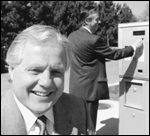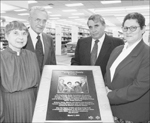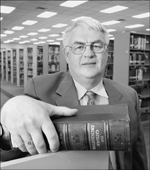 |
| Illustrations by Jack Hornady |
On a seemingly ordinary day two years ago, Wilfred and Helen Sopchyshyn were visiting Newman Theological College and St. Joseph Seminary, a Roman Catholic institution in Edmonton, Alberta. The couple--he a retired Catholic school teacher, accountant, and insurance salesman; she a retired teacher--had been donating to Newman for about forty years. Increasingly they wondered whether their money made any difference. "We gave $1,000 per year, and nothing would show up anywhere in the improvement of the school," said Wilfred.
On this day, as the couple wandered the grounds, they noticed new library books scattered here and there for lack of space. So the couple dropped in to talk to Bill Lerner, executive director of the school's foundation. "We said, 'We think the best thing to do is build a library for the books,'" recalled Wilfred. The couple asked whether any other projects needed funds, and Lerner mentioned the student residences.
"At the end of the conversation, they left promising $3 million," remembered Lerner. The money was earmarked for a new library and student residence. The story is a fund-raiser's dream, and it happens maybe once in a career. In almost every respect, however, the story followed the principles of successful fund-raising, which apply whether a school's annual budget is $100,000 or $100 million.
On average, two-thirds of a Canadian theological school's budget comes from tuition and facilities and the rest from annual fund-raising. Some schools also receive government grants, money from foundations and corporations, or national church donations, but even these schools rely on additional fund-raising to survive.
The two main types of fund-raising appeals are for annual operations and for capital expenditures. According to 1999 data for Canadian schools from the Association of Theological Schools, the median amount of total gifts for current operations was $163,000, with a low of $14,500 and a high of $2.9 million. The median for total gifts for capital purposes was $54,600, with a low of zero and a high of $3.4 million. To raise that money, fund-raisers generally employ three tools: direct mail, events, and major donor development. Each tool borrows from the following four key fund-raising principles.
1. Making a Difference
The Sopchyshyns gave because they saw a need and a way to make a difference.
"We taught in the Catholic system, and we knew many teachers lacked proper training in the theological field," explained Wilfred. "We decided to change [our giving] to one lump sum to improve the situation."

|
| Brian Stiller is all smiles, standing in front a customer using the parking machine at Tyndale's newly paved parking lot, the result of the successful "Pave the Way" fund-raiser.
Photograph by Michael Hudson
|
That motivation is typical of people who give to theological schools, according to Brian Stiller, president of Tyndale College and Seminary, an evangelical institution near Toronto. Under Stiller's leadership the school went from the verge of bankruptcy four years ago, with a debt load of $6.4 million, to financial viability with a debt of $1 million today.
"The most important thing, in the Baby Boomer group especially, is that they want a sense that their giving matters," said Stiller.
With that principle in mind, the school repackaged its direct mail appeals, breaking down fund-raising into specific projects targeted to donor-giving levels. "For the donor that gives $100 or less, for example, we will identify a goal which is less than the annual fund," said Stiller. "We develop a smaller objective, say $100,000 for library books or an air conditioner. They can see where their gift is able to impact the total goal and how they can help us achieve that goal."
The school's most successful direct mail campaign wasn't for books, buildings, or bursaries, though, which are common favorites, but something more down to earth (literally): paving the parking lot.
The school's gravel lot kicked up dust all summer and deteriorated into axle-wrecking potholes with the slightest drizzle. The upscale neighbors, who lived in million-dollar mansions, complained regularly. The school had been ordered to fix the problem five years earlier and had promised to comply but didn't for lack of funds. Finally, mere months after Stiller took over, the school got a "fix it or we'll shut you down" letter from the city. It didn't matter that the school was in the midst of its worst financial crisis, or that enrollment had dropped by 40 percent, or that it was the beginning of summer--the dead zone for fund-raising.
So, on June 15, 1997, the school launched the Pave the Way campaign. "Order to pave parking lot threatens recovery plan" warned the outside envelope. Inside, donors learned that a $500 gift would pave one spot and buy a plaque in the donor's name by that space. Plus, every dollar they gave would be matched by an anonymous donor up to $250,000.
Stiller agreed. The campaign reached its target, and the lot was paved within a few months. "I have never seen anything like it, but people gave because they knew what an abomination the parking lot was," he said. Paving the lot also became a symbol of renewal for the school. "People thought, 'Oh, we really are going to live, if we can clean up the worst mess,'" recalled Stiller.
Ironically, the plan to have plaques on parking spaces didn't work out as Stiller had hoped. While a number of donors had plaques installed marking their "Pave the Way" donations, the plaques ended up falling off the cement curbs. The whole idea was scrapped, and the plaques were installed in the lobby of Tyndale's building.
2. Transparency
A close corollary to the need to see donations make a difference is the need to see exactly how donations are spent.

|
| Helen and Wilfred Sopchyshyn, left, donated $3 million to Newman Theological College to build a new library and student residence. They are pictured here with their son and daughter-in-law Clint and Geneva Sopchyshyn and the plaque commemorating their gift, which is displayed in the Sopchyshyn Family Library.
Photograph by
Bruce Edwards
|
For the Sopchyshyns that meant creating a separate bank account for the $3 million, which was donated in installments and paid out to contractors as work was completed. The couple oversaw construction of the two buildings, including approval of blueprints, and insisted work be completed on budget and on time, or there would be penalties. Lastly, they didn't want anyone to know their identity till the work was completed.
"The days are over when we can ask people to be good stewards and not tell them what is going on," said Sheldon Oleksyn, director of development at the College of Emmanuel and St. Chad, an Anglican theological college in Saskatoon, Saskatchewan.
Direct mail letters and donor visits provide that opportunity. Oleksyn's most recent appeal letter to the Anglican Church Women provided an update on changes at the school, spelled out several ways they can target their money, and reiterated why theological schools are important. "No matter what transpires in the months and years ahead, the college will be necessary in the discernment and training of future leaders of the church. Faithful and effective leaders will ensure that the Anglican Church not only survives but also flourishes!" stated the letter.
The bottom line, though, is people want something in return for their donation. For some donors, that's recognition.
3. Something in Return
Newman named the library and residences after the Sopchyshyn family, which was important to them, given that they had only one child, who did not have children. "They wanted it to be remembered that once upon a time the Sopchyshyn family had once walked the face of the earth," recalled Lerner.
For other donors, the payback is a good time. Both Newman and Tyndale, for example, sponsor golf tournaments to give donors a good time for a good cause.
Newman's tournament, now in its seventh year, attracts 180 participants and nets about $45,000 in profit. The Allard Foundation sponsors the event, participants pay $250 (and receive a tax receipt for $150), and businesses or individuals can buy a hole for $1,000 to display advertising. The tournament includes a breakfast at the clubhouse, a steak barbecue, and a "hamburger barbecue and suds" on campus the night before. "It brings more people on site, and they get to know more about this place," said Lerner.
Tyndale's tournament, in September, attracts 100 golfers and raised $25,000 last year. It features a dinner and an inspirational speaker. The last two years it was Paul Henderson, who scored the winning goal in the 1972 Canada-Soviet hockey series. Stiller called the tournament a "prospecting event."
"If people have a great meal, good times with friends, feel inspired, and receive good information about the school," he pointed out, "they will say 'These are good people.' Then they are more open to a personal call from me."
Both Newman and Tyndale also raise money from an annual dinner. Tyndale's, held in April, features a speaker (this year it was Tony Campolo) and nets about $100,000.
 |
|
Bill Lerner, vice president of Newman's foundation, helped two long-time $1,000-a-year annual fund givers to discern how they could “make a difference” at the school through a large one time gift. The result was a new library (shown here) and a student residence.
Photograph by
Bruce Edwards
|
The Friars Club dinner is the key social event of the year for Edmonton's upwardly mobile Catholics, Lerner said; it raises about $45,000 for Newman. The $150-per-plate dinner attracts about 500 people and features a gourmet meal (liquor included), dance, and silent auction. The priciest item auctioned off to date was Wayne Gretzky's jersey from his days with the New York Rangers, which fetched $6,000. The jersey, signed by the "Great One," was donated by the priest who married Wayne and Janet Gretzky.
Newman also holds a Christmas event on campus each year: the Gift of the Magi, featuring choirs, sleigh rides, and a craft sale. In its eighth year, the event attracts about 1,500 people and raises about $3,000. "It's more of a friend-raiser, not a fund-raiser," says Lerner.
On-site events can be crucial for fund-raising, though. It was while attending a campus event that the Sopchyshyns first noticed the need for a new library.
Elsewhere, the Atlantic School of Theology, an Anglican, Roman Catholic and United Church school in Halifax, Nova Scotia, sponsors a St. Valentine's Day dessert night, featuring singing waiters drawn from opera students at nearby Dalhousie University. The event also features a few "celebrity" servers, drawn from business, politics, the military, or media. The $50-per-plate event attracts about eighty participants and nets about $2,400 for the school.
Kevin Moynihan, head of fund-raising and public relations at AST, called it a "cultivation" event. "These folks become part of our donor base, but they are also capable of making larger gifts if they can spend $100 on an evening. We would ask down the road [for a larger donation]."
It's too early to tell the long-term value of such events, added Moynihan, but many of the people who attend are major donors or sit on committees. Most important, they introduce the school to other potential donors, and vice versa.
AST also stages a Christmas tree lighting at the school that raises about $12,000. People can purchase a light in someone's name for $10 to $100, or a wreath, angel, or star for $250 to $1,000.
Not every school is sold on events fund-raising, however, preferring a person-to-person approach.
4. Personal Touch
"Rather than planning a golf tournament, you'd be better off to take twenty-five of your top donors and spend those hours visiting them and finding out what they like and trying to find a match [for their giving]," said Oleksyn, of Emmanuel and St. Chad. The trend in giving, he added, is toward fewer donors providing more of a school's total income. "Institutions that are going to ride the wave into the next decade are going to be ones that are well endowed and have effectively tapped into their major donor base. If you're going from phonathon to phonathon and depending on direct mail, you will be in trouble."
Still, like many schools, Emmanuel and St. Chad holds phonathons. "Last year, we raised about $40,000 and only contacted 747 donors," said Oleksyn. "Students made the calls. People want to talk to students. That's who they are supporting." The campaign had a 50 percent response rate, compared to an average of 2 percent for direct mail. Personal visits still yield the best rate though: 75 percent. "That tells the story right there. The more personal contact you have, the better you do," said Oleksyn.
Regent College in Vancouver, British Columbia, also frowns on events as a waste of energy. The school hosts six low-key lunches, featuring talks by the president and students, but primarily relies on major donor development (anyone who gives more than $10,000).
"Our philosophy is relationship fund-raising. We build close relationships and keep very close to our donors," says Ross McQuarrie, vice president of development. "Apart from that, we don't have much of a strategy. We work that one very hard." McQuarrie and the president regularly visit major donors to update them on happenings at the school and provide a time of ministry and prayer to the donor.
Enlisting a president in major donor fund-raising is key, according to Dave Stephens, director of development and recruiting at McMaster Divinity College in Hamilton, Ontario. "They want to talk to the organ grinder not the monkey. I let them talk to the organ grinder, and I make sure the organ grinder knows that's part of his job," said Stephens.
Ultimately, a personal face was also important to the Sopchyshyn family. They didn't give after reading a brochure but after talking to a person--and the person was known to them.
Very few fund-raisers may ever experience something like Bill Lerner's Sopchyshyn moment. By following these principles of fund-raising, however, they will have other successful fund-raising stories to tell.